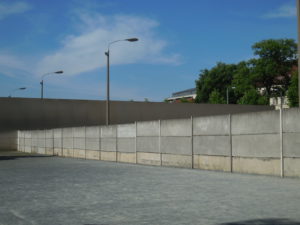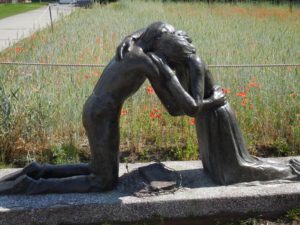Berlin Wall Memorial: The Divided City during the Cold War
By Tracy A. Burns
Berlin Wall history

Dividing West and East Berlin from 1961 to 1989, the Berlin Wall is one of the most dominant symbols of the Cold War. The wall stretched more than 155 kilometers around West Berlin and measured between 3.4 and 4.2 meters in height. There were 186 observation towers and 20 bunkers at the border. East Germany deterred would-be escapees by erecting mesh fencing, signal fencing, anti-vehicle trenches, and barbed wire. Fierce dogs proved faithful guards, too. Overall, more than 100,000 people tried to escape over the Wall, and about half of the attempts were successful. It is estimated that around 200 people died while trying to flee to the West.
The memorial and its sights
While most of the Wall has been demolished, the Berlin Wall Memorial at Bernauer Strasse offers visitors the chance to see 220 meters of the original concrete wall. The monument stretches 1.4 kilometers along the former border and includes a Documentation Center, Chapel of Reconciliation and other places of interest. Pop into the Nordbahnhof S-Bahn Station to look at the exhibition about border stations and ghost stations during the Wall’s existence. Features of the memorial
At the memorial, you will see a replica patrol road, remnants of the inner wall, a bell tower, and a watchtower. There is also a mock escape tunnel from the 1960s. You’ll also see the former death strip, an area that provided border guards with a clear view for firing.
The Documentation Center
A stop at the Documentation Center is a must. As you enter, don’t forget to pick up the four free brochures of orientation maps and incident markers that clearly pinpoint all the sights and exact locations of various escape attempts. In one brochure, you will read that, on the first day the wall was being built, a VW Beetle from East Berlin sped through the barbed-wire barrier and came to a halt in the West, the driver has made a successful bid for freedom.
The Documentation Center: the exhibition
At the Documentation Center, take your time at the exhibition “1961/1989 The Berlin Wall,” which not only narrates the story of the division of East and West Berlin but also places events in a wider historical context. The most impressive feature of the exhibition is formed by the stories of many people, some who succeeded in escaping and others who did not. It also highlights the work of escape helpers and informers. The individual stories help form a broad picture of life in East Berlin.
Harry Seidel, the escape helper
For example, the exhibition tells the story of racing cyclist Harry Seidel who was not permitted to race in the 1960 Olympics because he was from East Germany. He successfully came to the West and even smuggled his wife and baby to freedom. Dedicated to helping others flee, he dug escape tunnels. He helped 100 people escape before the secret police nabbed him in a tunnel in November of 1962. He was sentenced to life imprisonment.
Siegfried Uhse, the informer
You’ll also read the story of hairdresser Siegfried Uhse, a resident of West Berlin and an informant for the secret police. He convinced escape helpers that he wanted to help his girlfriend and her mother flee and wound up alerting the secret police to five escape tunnels by the end of 1963. No less than 89 would-be escapees and escape helpers were arrested because of his work.
The inhabitants of Bernauer Strasse
You’ll get to know the people who lived on Bernauer Strasse, and you’ll appreciate the inhabitants’ determination to experience freedom. Some East Berliners on Bernauer Strasse escaped by jumping into rescue nets of the West Berlin fire department or by jumping off their roofs. Others slid down ropes from their apartments on the border.
Other features of the exhibition and observation deck
The Documentation Center also showcases a multimedia exhibit of the Divided City and the Wall in movies and focuses on everyday life in East Berlin during the Cold War. You will come to understand how West Berlin was severely affected by the building of the Wall. There also is an observation deck with superb views of the Wall remnants and border fortifications.
A top sight in Berlin
 Everyone should visit this important sight in Berlin because the Wall not only shaped the city but also had a major impact on Europe and the world. The exhibits are fascinating, the stories of inhabitants moving. Visitors should familiarize themselves with the history of the city and country. The Berlin Wall Monument places the Cold War era in a significant historical context and makes sure visitors do not forget those tragic decades in East Berlin.
Everyone should visit this important sight in Berlin because the Wall not only shaped the city but also had a major impact on Europe and the world. The exhibits are fascinating, the stories of inhabitants moving. Visitors should familiarize themselves with the history of the city and country. The Berlin Wall Monument places the Cold War era in a significant historical context and makes sure visitors do not forget those tragic decades in East Berlin.



